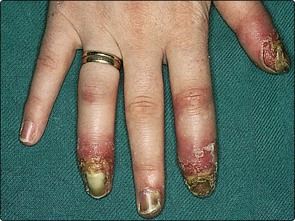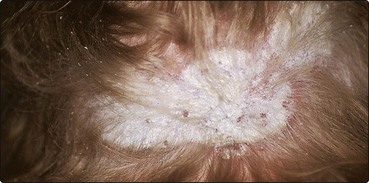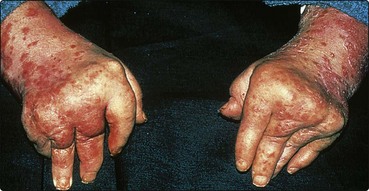Psoriasis – Management and complications
Management
The non-infectious nature of psoriasis, its relapsing nature and the likely need for long-term therapy should be explained. A sympathetic approach is helpful, and patients often obtain support from the self-help group The Psoriasis Association (see p. 132). Treatment is tailored to the patient’s particular requirements, taking into account the type and extent of the disease, and the age and social background (Table 1).
| Type of psoriasis | Treatment options |
|---|---|
| Stable plaque | Vitamin D analogue with topical steroid Dithranol (short contact), coal tar, tazarotene Narrow-band ultraviolet B |
| Extensive plaque | Narrow-band ultraviolet B (plus topicals) Methotrexate, ciclosporin, PUVA or Re-PUVA Biologics |
| Guttate | Topical steroids (mild/moderate), coal tar Narrow-band ultraviolet B |
| Facial/flexural | Topical steroids (mild/moderate); tacalcitol |
| Palmoplantar | Topical steroids (potent) Acitretin, PUVA or Re-PUVA |
| Generalized pustular; erythrodermic | Acitretin, methotrexate, ciclosporin Biologics |
Topical therapy
It is usual to prescribe topical agents as the first-line treatment.
Topical corticosteroids
Topical steroids have the advantage of being clean, non-irritant and easy to use. However, against this must be balanced the risk of side-effects (p. 23) and of precipitating an unstable form of psoriasis, especially on their withdrawal. Topical steroids are the treatment of choice for face, genitalia and flexures, and are useful for stubborn plaques on hands, feet and scalp. Potent steroids should not be applied to the face, although they may be used judiciously on palms and soles. Elsewhere, moderately potent steroids normally suffice. Their use must be monitored carefully. Creams are often preferred to ointments. Lotions and gels are available for the scalp.
Keratolytics and scalp preparations
Hyperkeratotic psoriasis of the palms and soles can be treated with 5% salicylic acid ointment. Scalp psoriasis (Fig. 1) responds to 3% salicylic acid in a cream base (sometimes with 3% precipitated sulphur) applied daily or every 2 or 3 days, and is used in combination with a tar-containing shampoo (e.g. Alphosyl 2 in 1, Capasal, Polytar, T/Gel). Coconut oil compound (e.g. Cocois, with tar, salicylic acid and sulphur) also helps scaly scalps.
Systemic therapy
Psoriasis that is life-threatening, unresponsive to adequate topical treatment or restricting the ability to work (Fig. 2) may require systemic therapy. Benefits must be weighed against side-effects. The use of potentially toxic drugs is justified by their ability to transform a patient’s life from severely restricted to nearly normal. Phototherapy and photochemotherapy are outlined on page 106.

Fig. 2 Acrodermatitis continua variant of psoriasis.
Sterile pustular changes with dactylitis are present on three fingers.
Biologic agents and other systemic treatments
Other immunosuppressive drugs can control psoriasis, but they are not as potent as methotrexate. Hydroxycarbamide has the advantage of not affecting the liver, but it can suppress the bone marrow. Fumaric acid esters are effective in some cases (p. 114). Biologic agents are very effective but expensive (see p. 114).
Complications
Psoriasis may be complicated by arthropathy, erythroderma and the Koebner phenomenon (p. 28, Fig. 2). It is associated with the metabolic syndrome and an increased risk of cardiovascular disease.
Psoriatic arthropathy
1. Asymmetrical arthritis. A small number of joints are usually involved, with few erosions and good preservation of function.
2. Symmetrical polyarthritis. This form is associated with erosions, deformity and loss of function (Fig. 3). It is distinguished from rheumatoid arthritis by predominantly affecting distal interphalangeal joints and by the rheumatoid factor test being negative.
3. Predominant spondylitis. This type is similar to ankylosing spondylitis and may be accompanied by a peripheral arthritis, although it behaves independently of it.
Erythrodermic psoriasis
Inpatient treatment is needed for this condition, often with systemic drugs. Details are given on page 44.
Treatment of psoriasis
Side-effects are often the limiting factor in psoriasis treatment.
Topical treatment is usually the first approach:
 Steroids: popular and effective but beware of side-effects.
Steroids: popular and effective but beware of side-effects.
 Vitamin D analogues: clean and effective but may irritate.
Vitamin D analogues: clean and effective but may irritate.
 Coal tar: safe but messy and not very popular with patients.
Coal tar: safe but messy and not very popular with patients.
 Dithranol: effective, irritant, rather impractical for home use.
Dithranol: effective, irritant, rather impractical for home use.
 Keratolytics: useful for scalp disease combined with tar or sulphur.
Keratolytics: useful for scalp disease combined with tar or sulphur.








